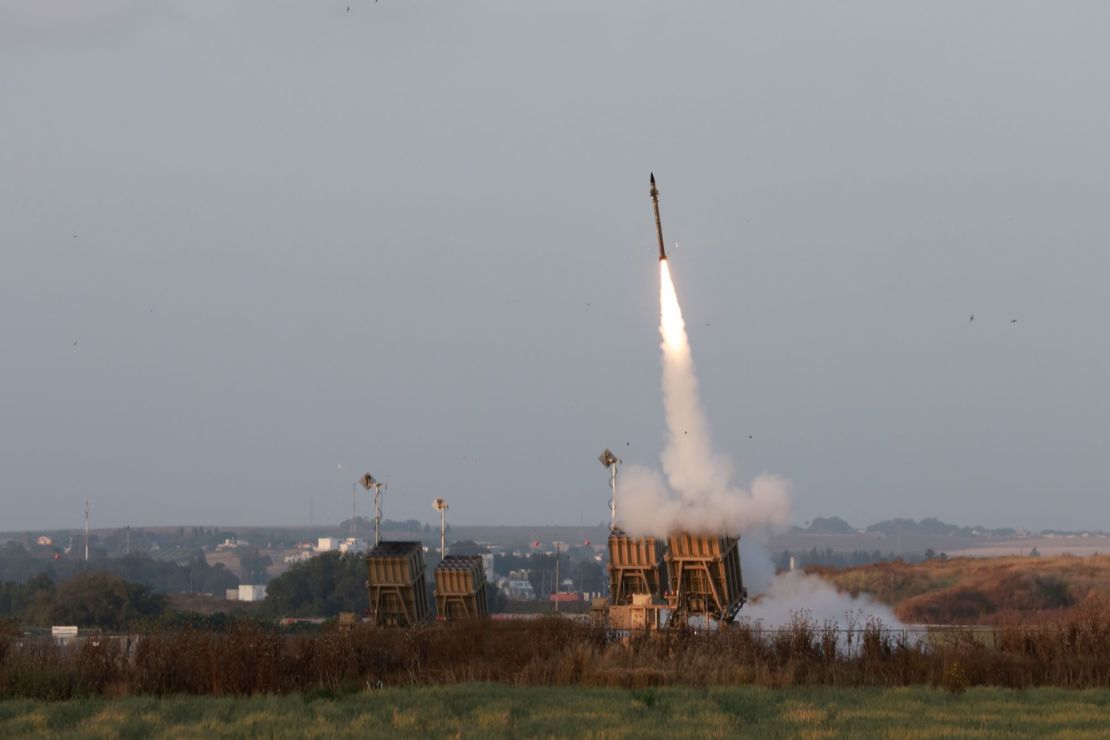
Almost all the ballistic missiles and drones Iran launched at Israel in an unprecedented attack late Saturday were intercepted and failed to meet their mark, according to Israeli and American officials, highlighting the formidable, and multi-layered missile defense deployed by the two allied partners.
Most of the more than 300 Iranian munitions, the majority of which are believed to have been launched from inside of Iran’s territory during a five-hour attack, were intercepted before they got to Israel, more than 1,100 miles (1,770 kilometers) from their launch points.
Israel’s military said Sunday that “99 percent” of projectiles fired by Iran were intercepted by Israel and its partners, with only “a small number” of ballistic missiles reaching Israel.
In total, around 170 drones, more than 30 cruise missiles and more than 120 ballistic missiles were launched at Israel by Iran overnight Saturday, the military said.
In a call Sunday, US President Joe Biden told Israeli Prime Minister Benjamin Netanyahu that constituted a win for Israel as nothing of “value” was hit, a senior US administration official told CNN.
US officials said more than 70 drones and three ballistic missiles were intercepted by US Navy ships and military aircraft, without giving details of exactly what defenses were used to bring down the projectiles.
The US Navy shot down at least three ballistic missiles using the Aegis missile defense system aboard two guided-missiles destroyers in the eastern Mediterranean, officials told CNN’s Oren Liebermann at the Pentagon.
US warplanes also shot down Iranian ordnance, Liebermann reported. While it was not revealed from where those US jets operated, there are US Navy aircraft carriers and land-based aircraft well within range of the region.
Biden said in a statement the US was well-prepared to help defend Israel against the Iranian attack.
“To support the defense of Israel, the US military moved aircraft and ballistic missile defense destroyers to the region over the course of the past week,” the US president said in a statement.
“Thanks to these deployments and the extraordinary skill of our servicemembers, we helped Israel take down nearly all of the incoming drones and missiles,” Biden said.
Britain said it was also prepared to intervene using Royal Air Force aircraft it has in the region.
“These UK jets will intercept any airborne attacks within range of our existing missions, as required,” a Defense Ministry statement said.
An Israeli military spokesperson also said France was involved in blocking the Iranian attacks.
“We are working closely with the US, UK and France who acted tonight. This partnership has always been close, but tonight it manifested itself in an unusual way,” the spokesperson said.
Meanwhile, Israel operates a range of systems to block attacks from everything from ballistic missiles with trajectories that take them above the atmosphere to low-flying cruise missiles and rockets.
Israel’s Iron Dome system has been in the headlines often since the country began its military offensive in Gaza in response to the October 7 Hamas attacks inside Israel that sparked the current hostilities in the region.
The Iron Dome is the bottom layer of Israel’s missile defense, according to the country’s Missile Defense Organization (IMDO).
There are at least 10 Iron Dome batteries in Israel, each equipped with a radar that detects rockets and then uses a command-and-control system that quickly calculates whether an incoming projectile poses a threat or is likely to hit an unpopulated area. If the rocket does pose a threat, the Iron Dome fires missiles from the ground to destroy it in the air.

The next rung up the missile defense ladder is David’s Sling, which protects against short- and medium-range threats, according to the IMDO.
David’s Sling, a joint project of Israel’s Rafael Advanced Defense System and US defense giant Raytheon, uses Stunner and SkyCeptor kinetic hit-to-kill interceptors to take out targets as far as 186 miles away, according to the Missile Threat project at the Center for International and Strategic Studies (CSIS).
Above David’s Sling are Israel’s Arrow 2 and Arrow 3 systems, jointly developed with the United States.
The Arrow 2 uses fragmentation warheads to destroy incoming ballistic missiles in their terminal phase – as they dive toward their targets – in the upper atmosphere, according to the CSIS. The Arrow 2 has a range of 56 miles and a maximum altitude of 32 miles, according to the Missile Defense Advocacy Alliance, which called the Arrow 2 an upgrade of the US Patriot missile defenses Israel once used in this role.
Meanwhile, the Arrow 3 uses hit-to-kill technology to intercept incoming ballistic missiles in space, before they reenter the atmosphere on their way to targets.
Israel also has state-of-the-art fighter aircraft, including F-35I stealth jets that it has used to shoot down drones and cruise missiles before, according to news reports.
The ballistic missiles that did reach Israel fell on the Netavim Air Base in southern Israel, Israel’s military spokesman said, adding that they caused only light structural damage. The base was functioning and continuing its operations following the attack, with planes continuing to use the base, he added.
Photos released by the Israeli Air Force early Sunday showed F-35 and F-15 fighter jets returning to their bases in Israel after what were called successful “interceptions” and “aerial defense missions.”
Some of the weapons launched at Israel were fired from Iraq and Yemen, the spokesman added.
CNN’s Irene Nasser, Eugenia Yosef and Benjamin Brown contributed to this report.




